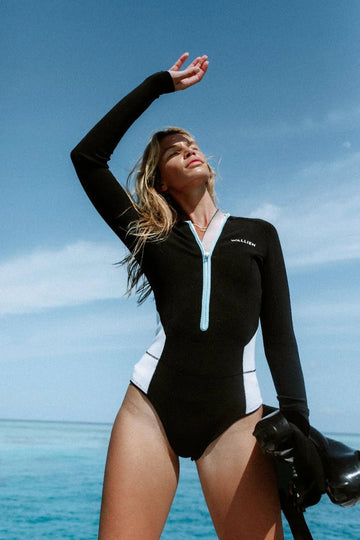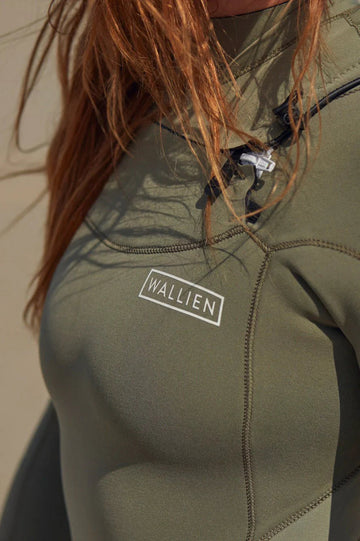The Ultimate Guide to Layering Under Your Wetsuit
Why You Need to Layer Your Wetsuit
When it comes to cold water activities like diving or surfing, wearing a wetsuit is essential to keep your body protected from the elements. However, simply wearing a wetsuit may not provide enough insulation in extremely cold water temperatures. This is where wetsuit layering comes into play.
Layering under your wetsuit can provide additional warmth and comfort, allowing you to stay in the water for longer periods without feeling too cold. In this guide, we will explore the different options for layering under your wetsuit, both for cold water and summer conditions.
Cold Water Wetsuit Layering Guide
The Importance of Thermal Rash Vests in Winter
One of the key components for cold water wetsuit layering is a thermal rash vest. These specially designed tops are made from insulating materials that trap heat close to your body, keeping you warm even in freezing water temperatures. Thermal rash vests are typically worn underneath your wetsuit, providing an additional layer of insulation.
Not only do thermal rash vests help to keep you warm, but they also provide additional protection against chafing and skin irritation caused by the wetsuit. Their quick-drying properties also ensure that you stay comfortable throughout your water activities.
But did you know that thermal rash vests can also offer other benefits? In addition to their insulating properties, some thermal rash vests are equipped with UV protection, shielding your skin from harmful sun rays. This added feature is especially important if you plan on spending long hours in the water, as it helps prevent sunburn and reduces the risk of skin damage.
Stay Warm with Thermal Wetsuit Shorts
In addition to a thermal rash vest, thermal wetsuit shorts are another great layering option for cold water conditions. These shorts are designed to be worn underneath your wetsuit and provide insulation for your lower body, including your thighs and buttocks.
Thermal wetsuit shorts are typically made from neoprene or similar materials, which offer excellent insulation properties. They are also designed to be flexible, allowing for a full range of motion while keeping you warm.
But did you know that thermal wetsuit shorts can also enhance your performance in the water? The snug fit of these shorts not only keeps you warm but also improves your hydrodynamics, reducing drag and allowing you to move through the water with greater ease. So not only will you stay warm, but you'll also be able to swim faster and more efficiently.
Keeping Your Head Warm with Wetsuit Hoods
When it comes to wetsuit layering, don't forget about your head. The head is one of the most sensitive areas to cold temperatures, and wearing a wetsuit hood can make a significant difference in keeping you warm.
Wetsuit hoods are designed to cover your entire head and can be worn either on their own or under your wetsuit. They are typically made from neoprene or similar materials, which provide insulation and protection against the cold water.
In addition to keeping you warm, wetsuit hoods also offer additional protection against sunburn and can help reduce the risk of ear infections caused by prolonged exposure to cold water. So not only will you stay cozy, but you'll also be safeguarded from the elements.
Protect Your Feet with Wetsuit Boots
Another important aspect of cold water wetsuit layering is protecting your feet. Wetsuit boots are specially designed footwear that provides insulation and protection for your feet, preventing them from getting cold and numb.
Wetsuit boots are typically made from neoprene material and are designed to be worn with your wetsuit. They come in various thicknesses depending on the water temperature and provide excellent insulation, allowing you to stay comfortable and warm during your water activities.
But did you know that wetsuit boots also offer enhanced traction? The soles of these boots are often made with non-slip materials, providing you with better grip on slippery surfaces such as rocks or boat decks. This added stability can help prevent accidents and ensure that you can confidently navigate any terrain.
Wetsuit Gloves: Essential for Cold Water Diving
Lastly, wearing wetsuit gloves is crucial for cold water diving. Just like the rest of your body, your hands need protection against the cold water temperatures to ensure optimal comfort and dexterity.
Wetsuit gloves are designed to provide insulation and protection for your hands, allowing you to maintain a firm grip and perform tasks underwater without feeling too cold. They are typically made from neoprene or similar materials and come in different thicknesses, depending on the water temperature.
But did you know that wetsuit gloves can also offer added durability? Some gloves are reinforced with extra layers of material in high-wear areas such as the palms and fingertips, increasing their longevity and resistance to wear and tear. This means that your gloves will not only keep you warm but also withstand the rigors of your underwater adventures for longer.
Summer Wetsuit Essentials
Choosing the Right Swimwear for Your Summer Wetsuit
While summer conditions may not require the same level of layering as cold water activities, there are still essential items to consider when wearing a wetsuit in warmer temperatures.
When it comes to choosing swimwear to wear under your wetsuit, opt for comfortable and breathable materials that allow for easy movement and quick-drying. Swimsuits made from synthetic fabrics like nylon or polyester are ideal choices for summer wetsuit layering.
But what else should you consider when it comes to selecting the perfect swimwear for your summer wetsuit? Well, let's dive a little deeper into the topic.
Firstly, it's important to choose swimwear that fits you well. A snug fit will ensure that your swimwear stays in place and doesn't cause any discomfort or distractions while you're in the water. Look for swimwear with adjustable straps or ties to customize the fit to your body shape.
Secondly, consider the style of swimwear that suits your preferences and needs. Some people prefer one-piece swimsuits for their sleek and streamlined design, while others opt for bikinis for more freedom of movement. Choose a style that makes you feel confident and comfortable.
The Benefits of Wearing a Rash Vest in the Summer
Even in warmer conditions, wearing a rash vest under your wetsuit offers several benefits. Rash vests provide protection against chafing and skin irritation caused by the wetsuit, while also offering an additional layer of sun protection.
Rash vests are typically made from lightweight, quick-drying materials that keep you cool and comfortable even in hot weather. They also help to prevent rashes and skin abrasions caused by the friction between your skin and the wetsuit.
But did you know that rash vests can also come in different sleeve lengths? Depending on your preference and the level of sun protection you desire, you can choose between short-sleeved, long-sleeved, or even sleeveless rash vests. This allows you to customize your level of coverage and comfort.
Additionally, some rash vests come with built-in UV protection, which is especially beneficial when spending long hours under the scorching sun. This added layer of sun protection can help prevent sunburns and reduce the risk of long-term skin damage.
By layering properly under your wetsuit, you can ensure maximum comfort and protection in both cold water and summer conditions. Whether it's wearing a thermal rash vest in winter or opting for lightweight swimwear in the summer, the right layering can make a significant difference in your overall water experience.
Remember, always choose quality materials and proper sizing for your layering items to ensure optimal performance and comfort. Stay warm, stay safe, and enjoy your time in the water!






